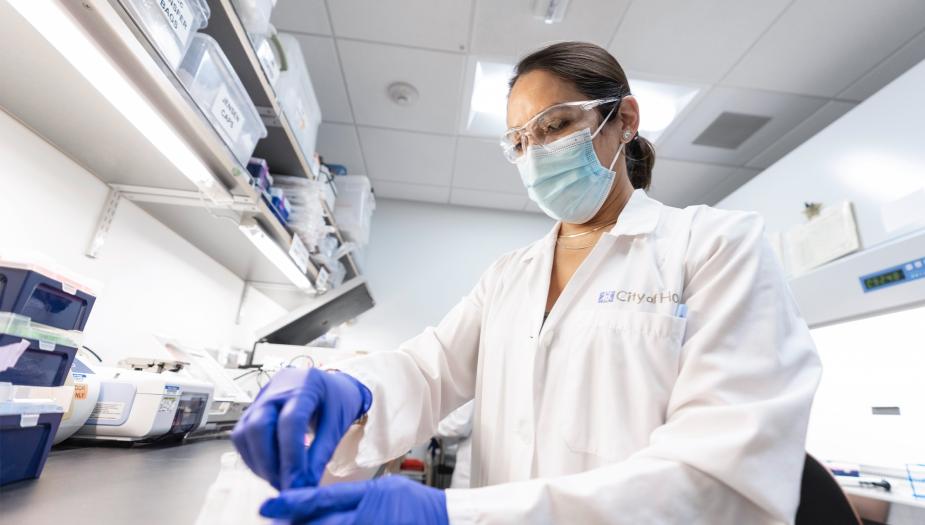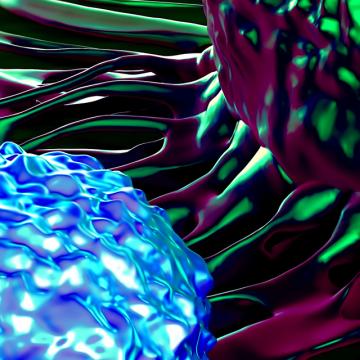Small Animal Studies
The Small Animal Studies Shared Resource (SAS-SR) comprises two components: the Small Animal Imaging Core and the Animal Tumor Models component. This combined resource provides exceptional quality services for City of Hope Comprehensive Cancer Center (COHCCC) Members for basic and translational preclinical studies in cancer biology, anti-cancer drug development, and stem cell therapeutic development.
The Small Animal Imaging component of the SAS-SR provides consultation, advanced imaging equipment, imaging services, hands-on training for COHCCC Members, and support for protocol and grant preparation. Current systems in the Imaging Laboratory include five units for bioluminescence/fluorescence optical imaging (Lago/Lago X/Ami HTX from Spectral Instruments Imaging and a PerkinElmer IVIS), a GNEXT PET/CT instrument (SofieBiosciences), a 7T MRI/PET (MRsolutions), and ultrasound imager (VisualSonics VEVO). These systems support molecular-based imaging to allow for the monitoring of cellular processes and the non-invasive assessment of pharmacokinetics and pharmacodynamics of therapeutic agents. The Animal Tumor Models component of the SAS-SR has established patient-derived xenograft (PDX) models of multiple cancers in collaboration with COH faculty and has developed next-generation humanized mouse models for research in cancer immunotherapy and in vivo drug metabolism/toxicity studies. The development of PDX models supports precision medicine allowing investigators to evaluate tumor growth and therapeutic response for individual patients. The Animal Tumor Models component also provides specialized drug delivery services, training for in vivo procedures, and support for protocol preparation and grant development. The SAS-SR is co-directed by Dr. Anna Wu, Professor and Chair, Department of Immunology and Theranostics and by Dr. Jun Wu, an Associate Research Professor of Comparative Medicine. Activities are supported by highly qualified personnel that maintain and operate the instrumentation.
Specific Aims for SAS-SR:
Aim 1. Provide consultation for the design, performance, and analysis of animal experiments.
Aim 2. Facilitate the development of new animal models and novel non-invasive in vivo imaging technology in support of cancer research.
Aim 3. Maintain the resources and expertise necessary for conducting animal research with high quality standards and in compliance with local, state, and national guidelines.
Members Utilization by %Revenue 2017–21: 96.7 Total (11.2 MCBC, 33.4 DCT, 26.6 CI, 25.5 HM)
Publications by Members: 88, 28 with Impact Factor >10
Grants Supported: 78 Total (3 ACS, 8 CIRM, 8 DoD, 4 LLS, 33 NCI of 46 NIH (32 R01, 1 U01))
How to Acknowledge the Small Animal Studies Core
If you’ve used our instruments and services for publications, presentations, grant applications, media releases, or any other form of media, it is extremely important to acknowledge the Small Animal Studies Core to demonstrate our involvement in the research of many laboratories. As a courtesy, we also request that you inform us of the publication of any images created by the Small Animal Studies Core.
- Training for investigators or their laboratory personnel to operate the optical imaging equipment (Lago and Lago X)
- Supervision in how to handle, prepare and run PET/CT scans of rodents (GNEXT and Inveon)
- Training in how to handle, administer, survey, track and dispose of radioactive materials used in imaging experiments
- Training in using analytical image software for quantitative image analysis
Positron emission tomography (PET) is a nuclear imaging technique that allows visualization, characterization and quantification of biological processes (metabolic and functional) in vivo. PET uses positron-emitting radionuclides such as Cu-64, F-18, Ga-68, I-124, Y-86, Zr-89.
PET can be combined with CT (computed or computerized tomography) that uses X-rays to visualize anatomical structures (e.g., tissues, organs, and skeletal structure). PET can also be combined with MRI (magnetic resonance imaging) that does not use radiation but a magnetic field and radio waves to create very detailed anatomical structures and superior soft-tissue contrast. The PET, CT and MRI images can be viewed separately or as a single, overlapping "fused" PET-CT/MRI image.
Bioluminescence and fluorescence imaging are non-radioactive optical imaging technologies.
PET/CT/MR Imaging Reservation Request
Submit this form to reserve small animal PET/CT/MR imaging requests. We will confirm the reservation in a timely manner via your email provided, usually in a day or so.
The principal investigators and the user in their lab are responsible for their animal welfare and will, at minimum, bring the animals to be imaged in and out of the core. Therefore, we encourage users to get trained so that they can conduct the studies under the core staff supervision to learn imaging techniques and image analysis.
To request or initiate services, please login or register via iLab Solutions.
- Two units for optical luminescence and fluorescence imaging 'Nith X-ray (Lago)
- Two units for optical lumine5cence and fluorescence imaging (Lago and IVIS S5)
- One dual-mode PET/CT scanner (GNEXT)
- One single mode PET and CT scanners (Molecubes)
- One dual-mode PET/MRI scanne r (7TMRI/PET)
- One single mode PET scanner (lnveon)
The Small Animal Studies Core is also equipped with two gamma counters (PerkinElmer and HIDEX) available for trained users for ex vivo biodistribution studies.
In a given year, City of Hope conducts more than 400 clinical trials enrolling more than 6,000 patients.

Xiao G, Chan LN, Klemm L, Braas D, Chen Z, Geng H, Zhang QC, Aghajanirefah A, Cosgun KN, Sadras T, Lee J, Mirzapoiazova T, Salgia R, Ernst T, Hochhaus A, Jumaa H, Jiang X, Weinstock DM, Graeber TG, Müschen M. Cell. 2018;173(2):470-84 e18. PMID: 29551267; PMCID: PMC6284818.
Alizadeh D, Wong RA, Gholamin S, Maker M, Aftabizadeh M, Yang X, Pecoraro JR, Jeppson JD, Wang D, Aguilar B, Starr R, Larmonier CB, Larmonier N, Chen MH, Wu X, Ribas A, Badie B, Forman SJ, Brown CE. Cancer Discov. 2021;11(9):2248-65. PMID: 33837065; PMCID: PMC8561746.
Caserta E, Chea J, Minnix M, Poku EK, Viola D, Vonderfecht S, Yazaki P, Crow D, Khalife J, Sanchez JF, Palmer JM, Hui S, Carlesso N, Keats J, Kim Y, Buettner R, Marcucci G, Rosen S, Shively J, Colcher D, Krishnan A, Pichiorri F. Blood. 2018;131(7):741-5. PMID: 29301755; PMCID: PMC5814935.
Wang D, Starr R, Chang WC, Aguilar B, Alizadeh D, Wright SL, Yang X, Brito A, Sarkissian A, Ostberg JR, Li L, Shi Y, Gutova M, Aboody K, Badie B, Forman SJ, Barish ME, Brown CE. Sci Transl Med. 2020;12(533). PMID: 32132216; PMCID: PMC7500824.
Park AK, Fong Y, Kim SI, Yang J, Murad JP, Lu J, Jeang B, Chang WC, Chen NG, Thomas SH, Forman SJ, Priceman SJ. Sci Transl Med. 2020;12(559). PMID: 32878978.
City of Hope is focused on basic and clinical research in cancer, diabetes and other life-threatening diseases.



